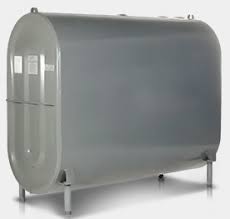Mike's Home Inspector BlogMichael Burfitt |
|
In my experience, Nova Scotia homes are divided almost equally between electric heat, boilers, and furnaces. There are many advantages and disadvantages for each type and a licensed HVAC contractor can provide advice on the best solution for your situation. For those who use home heating oil, you will require the use of a fuel storage tank. There are a few regulations regarding placement on property, acceptable types of piping and materials for the construction of oil tanks. The tanks are usually composed of two materials: steel or fibreglass and can be stored inside or outside. Edit in April 2024: I have enough inspections under my belt to confidently state that the ratio is about 70% steel and 30% fibreglass, at least around Central Nova Scotia. Lifespan of Oil Tanks Steel tanks are generally safe to use for about 20 years and fibreglass for 30+, however, you might need to replace a steel oil tank after 15 years and a fibreglass oil tank after 20 years. Why the difference? Insurance! While rare, an oil spill can cost 5 and even 6 figures to remediate, so insurance companies generally err on the side of caution and require replacement at these intervals. If you are buying a home with an Oil Tank, remember to check with your insurance company to find out what their policy is: we will provide you with the age of your tank provided the data plate is accessible and readable. Steel Oil Tanks
At one point, this was the only choice in Nova Scotia. While they are no longer permitted in some areas, such as Prince Edward Island, they are still in regular use in our province. These tanks tend to corrode from the inside out and can leak without warning. They are also extremely heavy and moving them inside can be difficult and expensive. The big advantage is cost: they are significantly cheaper than fiberglass. Fiberglass Oil Tanks These tanks are lighter, last a long time (unfortunately some insurers still require replacement long before they are unsafe to use) but come with a higher price tag. If insurers extend the timeframe before replacement is required, or the price of ferrous metal increases sharply, this will likely make this type of oil tank the undisputed choice. A Note About Underground Oil Tanks While beyond the scope of a home inspection, I am always on guard for the potentially serious issue of an abandoned, buried oil tank. Compared to other provinces I hear few stories about homeowners discovering them on their property as according to my research it was not common practice in our region due to our geology. As a home inspector, we are always looking for anomalies and seeing a vent and/or fill pipe in a strange place (such as the middle of a backyard) is one sign that would alert us that there may be a buried oil tank that needs to be investigated and remediated. Unfortunately, the only way to know for sure is to have a qualified contractor perform a detailed search. |
Archives
April 2024
Categories
All
|



 RSS Feed
RSS Feed

